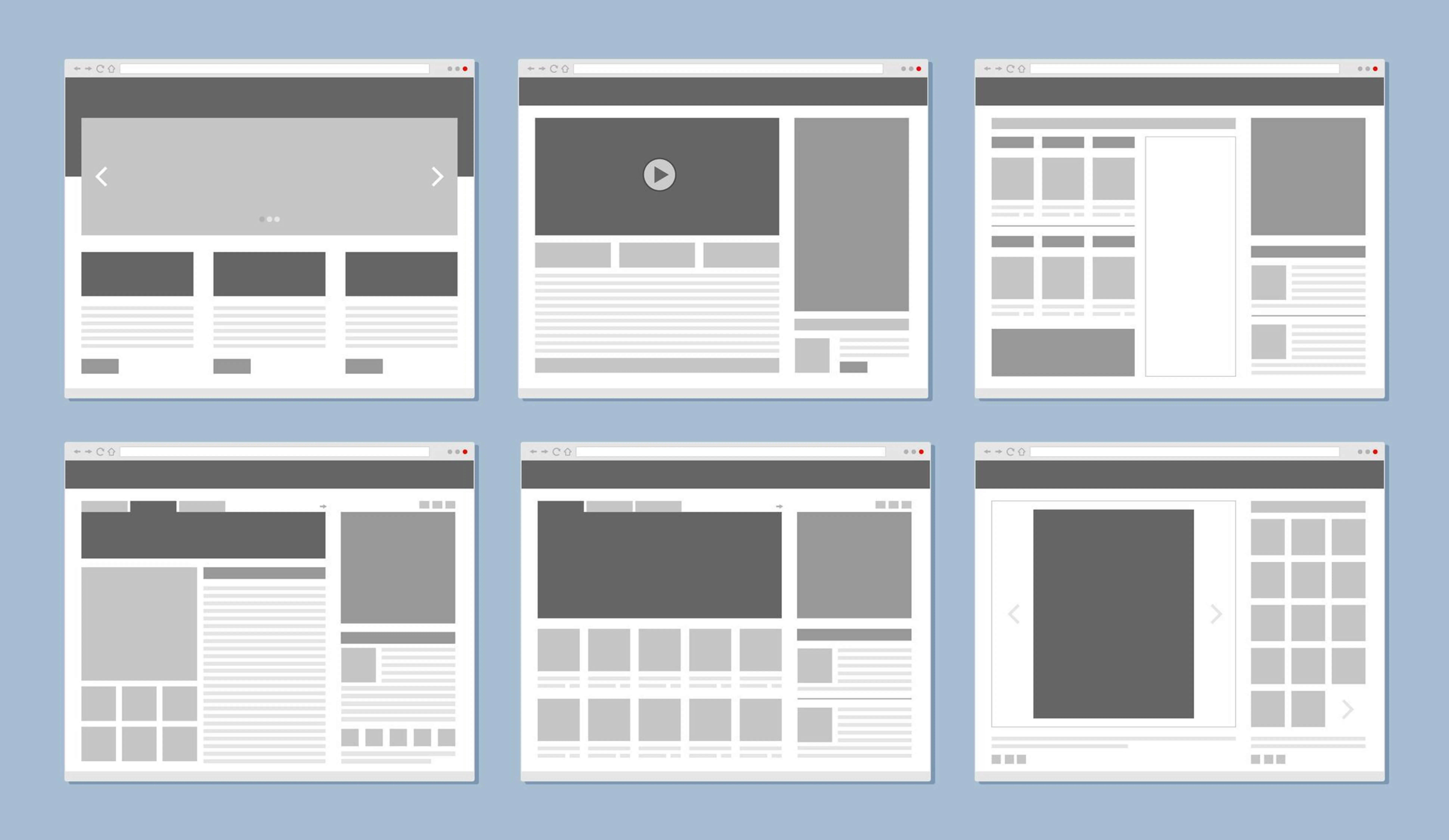Content Planning for Your Website - How to Approach It in 2024
In 2024, the approach to creating website content should be even more conscious and focused on delivering value to users. Proper content planning can significantly contribute to improving online visibility, engaging audiences, and building trust in your brand. Below you will find key principles and practical tips on creating content that speaks to your users and sets you apart from the competition.
Basic Principles of Creating Website Content

Effective online communication is based on several fundamental principles. Understanding and applying them in practice can significantly impact the success of your website.
Understanding the Purpose of Your Content
Common mistake: Creating content without a clearly defined purpose, leading to distractions for the audience and lack of conversions.
Better solution: Before you start writing, consider what exact purpose the text is supposed to serve – whether to inform, persuade, educate, or entertain. Then, adjust the style, tone, and structure of the content to that purpose. For example, if your goal is education, develop step-by-step content that guides the reader through all the necessary information.
Know Your Target Audience
Common mistake: Writing content "for everyone," making it irrelevant for a specific target group.
Better solution: Define your target audience and understand their needs, interests, and problems. Then, create content tailored to that group. For example, if your target are young parents, focus on parenting tips and present products, that make parents' lives easier.
Creating Scannable Content
Common mistake: Lack of clear structure, such as headings, bullet points, or highlighting key phrases, makes content difficult to quickly absorb, potentially leading to loss of interest and user departure.
Example: Suppose there is a health blog article discussing various natural treatment methods for common ailments like stress or insomnia. However, if the entire content is presented as a uniform block of text, without clear divisions or highlighting key information, readers may struggle to find the solution they're interested in.
Solution: The key is to structure content in a way that allows for easy scanning. This includes using headings that clearly communicate the topic of each section, using bullet points to present a series of points or steps, and bolding or italicizing key phrases or terms. Tools such as HTML tags can be used to organize content and facilitate navigation.
Analyze the Competition and Stand Out
Common mistake: Copying competitor content without adding own value, making the site one of many and not attracting attention.
Better solution: Conduct a thorough analysis of competitor content, then find a way to make your content unique. This can be a different perspective on the same topic, unique research, or even a personal tone of communication that makes your brand more human. For example, if competitors focus on the technical aspects of a product, you can describe real user stories and show how the product has impacted their lives.
Remember, content should be thoughtful and tailored to the needs of your audience. Use simple and understandable language, avoid excessive industry jargon that may be difficult for some users to understand. Strive to ensure every piece of content on your site brings value to readers and helps them solve their problems or answer questions they have.
Clear Presentation of Your Offer
A key element in attracting and retaining the audience's attention is clear and understandable presentation of what your company has to offer. A common mistake is burying key product or service information among irrelevant content, causing potential customers to quickly lose interest.
Better solution: Focus on presenting your offer in a clear manner right from the start of the page. Use headings, lists, and highlights to emphasize the most important benefits and features. For example, if you offer an innovative project management solution, begin with a clear statement of how your tool facilitates team work and what specific problems it solves.
Write as if to a Friend - Use Simple Language
Communicating in simple and direct language is the foundation of building a strong relationship with readers. Unfortunately, a common mistake is over-complicating the message by using industry jargon or too long, complex sentences, which can discourage or even confuse readers, diverting them from valuable content.
Example:
Consider a medical blog that publishes articles containing complicated medical terms and long paragraphs of text without division into smaller, digestible sections. An average reader, seeking information on simple home remedies for headache relief, may feel overwhelmed and misunderstood, resulting in leaving the site without obtaining needed information.
Solution:
To avoid this, it's crucial to apply the KISS principle (Keep It Simple, Stupid) – suggesting simplicity is the key to effective communication. Transform complicated terminologies and concepts into simple, understandable language. Imagine explaining the problem to a friend who does not have specialized knowledge in the field. Use short sentences, avoid an excess of technical terms, and always try to explain complex concepts in the simplest way possible.
Practical Application:
- Building Trust: Writing in simple language makes content more accessible, which builds trust and enhances the authenticity of the brand in the eyes of readers.
- Better Information Absorption: Simple language facilitates understanding of the message, increasing the likelihood that the reader will apply the presented solutions and take advantage of the offer.
- Greater Engagement: Texts that sound as if they were written by a real person, rather than by an impersonal corporation, are more likely to evoke an emotional response and engage readers.
Using Visuals to Strengthen the Message
Adding visual elements to text not only makes the content more attractive but also facilitates understanding and retention. The contemporary information recipient is increasingly visual, so it's important that textual content is supported by images, infographics, or video materials.
Extended Real-life Example: A book review site limits itself to textual descriptions, omitting covers, author photos, or infographics presenting main themes and characters. This format makes the content less attractive and harder to remember for readers.
Extended Solution: It's key to integrate high-quality visual materials with content that communicates key points or facilitates understanding of complex information. Adding photo galleries, infographics depicting statistical data, or video clips with interviews can significantly increase the content's substantive value and attractiveness.
Practical Application:
- Instructional Video: For educational content such as tutorials or guides, a short instructional video can be an excellent complement to the text.
- Photo Galleries: In travel articles, presenting a gallery of high-quality photos can evoke emotions and interest among readers.
- Infographics: For content containing statistical data, infographics allow complex information to be presented in an accessible and attractive form.
By effectively using scannable content and visual elements, creators can significantly increase audience engagement and facilitate information absorption.
Show Personality and Company Culture
People like to buy from people -- show that real individuals stand behind your company.
A blog written in a very formal language and focused mainly on self-promotion may come across as boring to the reader.
Use a natural, friendly tone and share stories that illustrate the values and culture of your company. For instance, instead of a formal mission statement, tell an engaging story related to your team. It could even be a description of a setback that turned out to be a valuable experience in the long run.
Display team photos on the 'About Us' page and share their personal quotes about working in your company.
Bring your company closer to the reader:
- regularly publish blog posts that show how you work on your products
- present success stories from customers or explain how your products help solve real problems
- create content that demonstrates that your company is more than just products -- it's a team of people with passion and a mission.
How to Come Up with Content for Your Website
Creating engaging and valuable content for a website is a challenge that requires creativity, strategy, and understanding of the audience's needs. Below, you'll find extensive guidelines on how to use idea generation tools, create audience personas, and map content to the stages of the customer journey.
Using Idea Generation Tools
In search of inspiration, it's worth reaching for tools that help track current trends and user preferences. However, improper use can lead to creating superficial and inauthentic content.
Example: Company XYZ used Google Trends to notice an increase in interest in eco-friendly packaging. They decided to create a series of articles on this topic, however, they ignored the specifics of their target group, which was more interested in practical aspects of recycling than general ecological trends.
Solution: Before creating content based on trends, conduct a thorough analysis to determine if a trend is indeed relevant to your target group. Instead of being guided solely by the popularity of the topic, combine data from trend tools with in-depth research on the needs and interests of your audience. Create content that combines trends with the unique needs of your users.
Creating Audience Personas
Audience personas are fictional characters that represent your ideal customers. They are an invaluable tool in content planning, but it's easy to fall into the trap of creating too general or unrealistic profiles.
Example: ABC Company created the persona "Eco-Eva," assuming that all their female customers are exclusively interested in ecological products. Although part of their audience had such interests, many were also looking for convenient and stylish products, regardless of their ecological aspects.
Solution: To avoid such mistakes, base the creation of audience personas on real data and interactions with customers. Regularly update and adjust these profiles based on new information and customer feedback. This will enable the creation of more personalized and accurate content.
Mapping Content to Stages of the Customer Journey
Understanding how different types of content fit into each stage of the customer journey is key to effective content planning. However, a common mistake is creating content focused only on one stage - most often the awareness stage.
Example: Company DEF focused on creating "How-To" content to attract users at the initial stage of the customer journey. Despite an increase in site traffic, the company noticed low conversion because it did not offer content supporting the purchase decision and loyalty after purchase.
Solution: To avoid this mistake, develop a content strategy that covers all stages of the customer journey, from awareness, through consideration and decision, to post-purchase loyalty. Offering valuable content at each of these stages will not only attract customers but also help build long-term relationships.
Creating Content for Specific Site Sections

Below are guidelines for creating content for the most important sections that will help you attract attention, build trust, present values, and share knowledge.
Home Page - How to Attract Attention
The home page is your company's online business card. A key mistake is overloading the homepage with too much information, which can overwhelm visitors.
Life Example: Company X placed a detailed description of all its services, several promotional banners, and a long-scrolling slider of customer reviews on the homepage. New users felt lost and quickly left the site.
Solution: Focus on a clear message and clear call to action (CTA). Use the space to present the value you provide to your customers in short, attention-grabbing slogans. Add buttons encouraging further exploration of your offer. Maintain simplicity and clarity.
About Us - Building Trust and Authenticity
The "About Us" section is where you can build a deeper relationship with your audience. The mistake is treating this section as just a duty, without putting effort into creating an authentic and convincing message.
Life Example: Company Y described its history in a generic and impersonal way, not mentioning the people behind it or the passion driving the company.
Solution: Tell your company's story in a way that reflects its character and values. Highlight the people, their competencies, and what motivates them. Show why you are unique. Add team photos to give the content a personal touch.
Services/Products - Presenting Value to the Customer
Presenting services or products is more than just a list of offerings. The mistake is focusing solely on technical features, overlooking benefits for the customer.
Life Example: Company Z listed the technical specifications of its products but did not explain how they solve the real problems of customers.
Solution: Describe each service or product by focusing on benefits for the user. Explain how your offer makes life or work easier. Use clear and understandable language, avoiding industry jargon. If possible, add case studies or reviews from satisfied customers.
Blog - Sharing Knowledge and Expertise
A blog is an excellent place to share knowledge, expertise, and build authority in the industry. The biggest mistake is publishing low-quality content that does not provide value to readers.
Life Example: Company A regularly publishes blog posts, but they are superficial articles that do not bring anything new to the industry discussion.
Solution: Focus on creating valuable, in-depth content that solves the real problems of the audience or answers their questions. Stay up-to-date with current trends and use them as inspiration for creating content. Engage readers in discussion, ask questions, and respond to comments.
How to Create Blog Content
Planning a Content Calendar
Planning a content calendar is key to regular and consistent engagement with your audience. Start by identifying the main topics that resonate with your audience, and then diversify the content to include different formats, such as guides, case studies, interviews, or analysis of trends. For example, if you run a blog about healthy eating, you can plan a series of articles on superfoods, recipes for healthy meals for every time of the day, as well as interviews with experts in the field of dietetics. Use tools like Trello or Google Calendar to organize your ideas and set publication deadlines.
Writing Engaging and Valuable Articles
To create engaging and valuable articles, focus on providing readers with concrete knowledge that solves their problems or answers their questions. For example, writing about an effective way to learn a foreign language, you can break the process into stages and propose proven learning methods, enriched with anecdotes from your experience or cases of people who have benefited from your advice. Remember to weave keywords naturally, focusing on creating valuable content for readers, not on excessive SEO optimization.
SEO for Blogs - Best Practices
To make your content visible in search engines, follow best SEO practices. Ensure that your articles contain long-tail keywords that reflect natural user queries, such as "how to quickly learn Spanish" instead of a short "learning Spanish." Use title tags and meta descriptions that are catchy and contain keywords. Additionally, link to other valuable content on your blog, which not only improves SEO but also engages readers.
Tips for Writing Content
Creating Scannable Content
Internet readers often scan content looking for information that interests them. To make it easier for them, use subtitles, bullet points, and numbered lists that help quickly find the sought-after data. For example, if you are writing about the best time management apps, present each app using a bullet list with the most important features and benefits.
Using Visualizations to Strengthen the Message
Images, infographics, and short videos can significantly strengthen the message of your article and make it more engaging. For example, creating a guide on stretching exercises, add photos or short videos demonstrating each exercise. This way, readers will quickly understand how to perform the movements correctly, increasing the value of your content.
Measuring Content Effectiveness
Understanding which content resonates with your audience is essential for optimizing your marketing strategy and maximizing ROI (return on investment) in your online activities. Without a thorough analysis of the effectiveness of published materials, you risk wasting resources on content that does not bring the expected results. Measuring content effectiveness allows not only identifying the most engaging topics but also improving future publications, which translates into better online visibility and greater audience engagement.
Analyzing Site Traffic and Engagement
Understanding the dynamics of site traffic and the level of user engagement is crucial for any content creator.
Example: A travel blog noted a drop in traffic, not knowing which content attracted the most attention. After analyzing data from Google Analytics, it was discovered that articles about "economical traveling" generated the most entries and engagement.
Solution: Regular monitoring of analytical data allows you to understand your audience's preferences and adjust the publication calendar. Use Google Analytics to track key metrics such as the number of unique visits, time spent on the site, or bounce rate, and then use this information to optimize content.
Conversion Tracking Tools
Understanding how content affects conversions is essential for maximizing the effectiveness of marketing efforts.
Example: An online store selling sports accessories noticed that some blog articles did not generate the expected number of sales, despite high traffic.
Solution: Implementing advanced tracking tools, such as Google Analytics Goal Tracking or Facebook Pixel, allows for precise tracking of which content effectively leads to conversions, such as product purchases, newsletter sign-ups, or contact form submissions. This way, you can better understand user behavior and optimize content for generating conversions.
User Feedback and Continuous Improvement
Actively listening to your community and responding to their feedback is key to continuous development and improvement of offered content.
Example: A veganism blog received feedback from readers about the lack of articles addressing the nutritional aspects of vegan diets.
Solution: Creating surveys or comment sections allows for direct feedback from readers about their needs and expectations regarding content. This feedback can be invaluable in planning future publications that will meet the audience's interests and needs.
Summary
In 2024, a key aspect of creating online content is to consciously focus on providing value to users. Effective content planning can significantly impact your online success by increasing visibility, engaging your audience and building trust in your brand. To create effective content, you must first of all understand the purpose of its creation, get to know the target group, create scannable content, analyze the competition, and present the offer in a clear way. It is important to write simply and understandably, use visuals to strengthen the message and show the company's personality and culture. It is also crucial to focus on content created with people in mind, not just search engines, and to constantly adapt the strategy based on the analysis of content effectiveness and user feedback. Remember that your profits may far exceed the cost of the website .

Adam Dowgird



